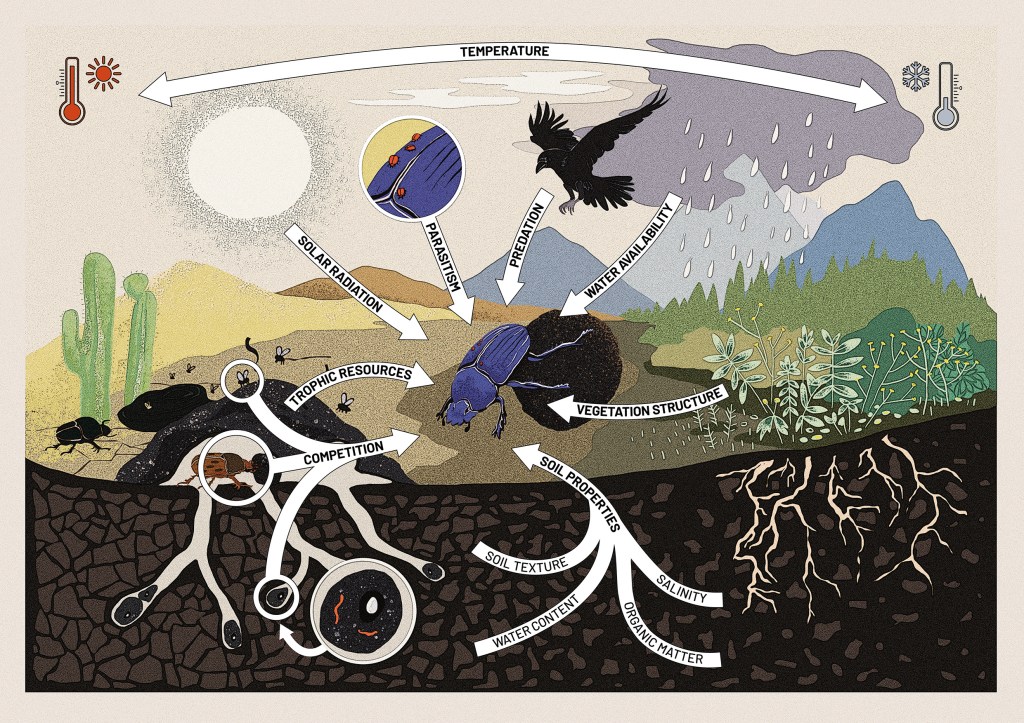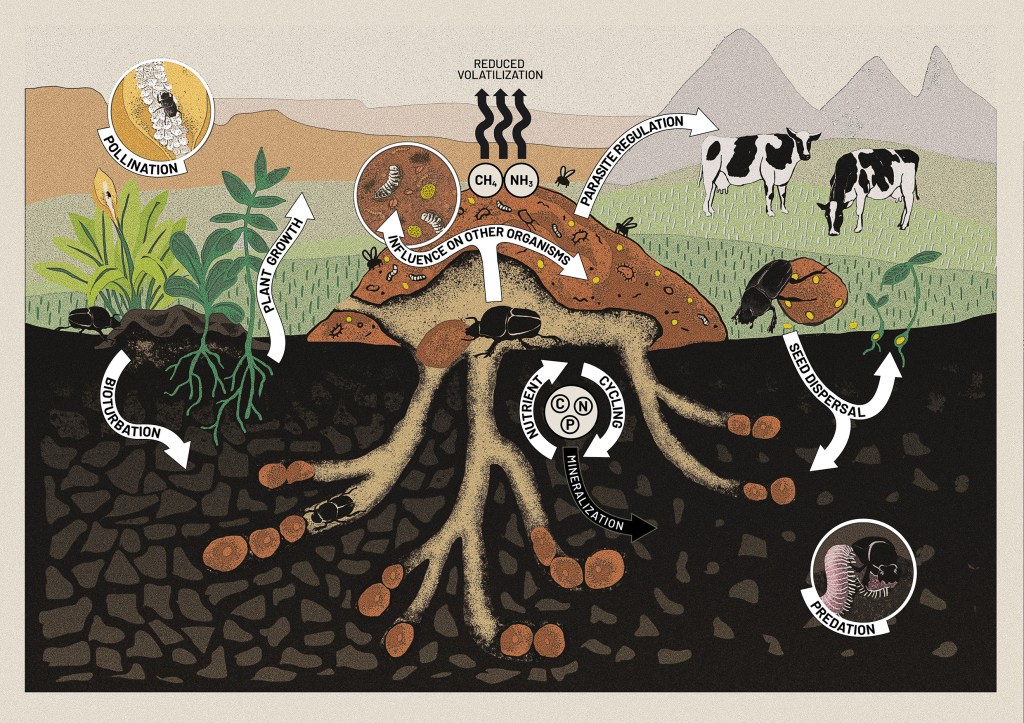This blog post is provided by Joaquín Hortal and Indradatta deCastro-Arrazola and tells the #StoryBehindthePaper for the paper ‘ A trait-based framework for dung beetle functional ecology’, which was recently published in Journal of Animal Ecology. In this blog post you can read how a group of dung beetle ecologists came together to establish a framework for the study of the functional ecology of dung beetles, worshiped by Ancient Egyptians but underappreciated today.
Functional ecology studies the attributes of organisms that either change due to environmental variations, affect their fitness or influence the habitat and the functioning of ecosystems. These attributes are called functional traits. Their study is well developed in vegetation science because plants have the odd habit of standing still and move only if they are carried by others, so it is easier to analyse how they react to changes or measure their effect on different ecosystem processes. Most animals have trouble staying still, so it may come as no surprise that measuring some of their traits and, especially, their impact on ecosystem functions is not as easy as it is for plants. In consequence, the development of animal functional ecology has been slower, and only recently the efforts of several groups of fierce animal ecologists have crystalized into a handful of trait databases and general handbooks that promote standardized measurements of traits for most vertebrates and some charismatic groups of invertebrates.
Believe it or not, dung beetles count among the most charismatic groups of insects. Besides their undeniable beauty, their relentless work is responsible for cleaning the mess that big (and not that big) mammals leave in most terrestrial ecosystems. They are nature’s quintessential recyclers and influence many ecosystem processes, while showing complex nesting behaviours that are often associated with parental care (unsurprisingly especially maternal). No wonder Ancient Egyptians worshiped them in the form of Kheper, the god of transformation and resurrection, and that the galleries they dig below cattle dung pads to place their nests inspired the pyramids and their burial chambers.

Perhaps affected by the pharaoh’s curse, many natural historians and dung beetle specialists have been studying their behaviour and measuring their traits for more than a century. Some of the most renowned ecologists –whose names we may keep confidential- have got their hands dirty studying these nice beetles, and they are behind seminal works on metapopulations or sexual selection. So we know a lot about the ecology and evolution of this group; some of their morphological traits are regularly measured, their nesting behaviours and trophic habits have been extensively studied, and we have several classifications into functional groups that work well to describe their different effects on dung decomposition and soil aeration.
But when we were planning the PhD on dung beetle functional ecology of one of us we realized that we lacked a comprehensive understanding of the functional significance of their traits. At the time, this meant that we could only guess which traits could be better to measure if we were to study certain functions, but we didn’t have a standardized way to measure them, nor how traits would relate to each other. Not to mention how their change in response to environmental variations may affect the delivery of key ecosystem services. So, one of us, Indra deCastro-Arrazola, started a massive review of dung beetle trait ecology, which ended up being a thorough, though thick, introductory chapter to his PhD thesis, which combined experiments to study the effect of traits on dung beetle functions, with fieldwork to measure their trait-based responses to aridity.
Based on that review, we started the quest of developing a framework for trait-based dung beetle ecology and a common handbook for the measurement of their traits. But you shouldn’t do this on your own, you need to debate and agree with other colleagues about questions including: which traits?; which responses to the environment and which ecosystem functions should be studied?; and finally, how can we measure them?. We started at the beginning. First, by finding a nice group of colleagues from all over the world; dung beetle ecologists are nice people, so that was an easy check. And second, by asking for funds to meet and discuss in person about traits; but as often happens, we did not manage to get funds for organizing a working group or workshop. The c. 10,000 species of dung beetles and their key role in many ecosystems are not that appealing, we guess.

Luckily, when it comes to dung beetle ecologists, nice means NICE: when a couple of members of the group came from Australia to a congress in Europe we contacted others, who scraped some funds from grants or slept on some friend’s couches to come to the Natural History Museum in Madrid and make an informal workshop where we laid the basis of the framework that we present here. This was, of course, before the pandemic. But it allowed us to start a series of focused online meetings where we discussed extensively the massive tables depicting the list of traits, responses and functions that support the review we have just published in Journal of Animal Ecology. Then, we had to prune (or rather chop down) an initial text that was more than twice the size that you can see now, to trim the most important facts about dung beetle functions and responses and the traits that may be involved in them. And there were many.
Dung beetles show diverse responses to variations in temperature, water, soil properties, trophic resources, light, vegetation structure, competition, predation, and parasitism. And have key effects in nutrient cycles, bioturbation and plant growth and seed dispersal, besides their large influence on other organisms that live on or use dung, including parasite regulation. Some of them are even pollinators or predators! In total, we identified 66 dung beetle traits, belonging to six categories: morphology, feeding, reproduction, physiology, activity and movement. And we linked these traits to their ecological roles based on known evidence or educated guess, sometimes extrapolating from what is known about other groups of invertebrates. 51 of them act as response traits, 31 as effect traits, and 27 of them act as both. By identifying which act as both response and effect traits, we have been able to determine which traits could change their influence in ecosystems as a response to environmental changes, thus modifying natural cycles. When we put together all the relationships between traits, responses and functions, it is clear that the interactions between the impact of stressors and the delivery of ecosystems services are quite complex. Unveiling this complexity may be key to understanding how global change will alter the functioning of nature as we know it.
Our review establishes a framework for the study of the functional ecology of dung beetles. A major result of our review is that, if we are to understand the ecological role of dung beetles and predict the changes in the ecosystem functions they mediate, we need to focus on standardized field measurements and experiments studying together several key traits. These include the omnipresent body size, but also the depth of the galleries they make, their dung allocation strategies, their investment in parental care, or the time when they are active. This research provides the guidelines to lay the foundations of functional ecology in other groups of invertebrates. For us, it also proved that being stubborn, getting your hands dirty, paying attention to all the literature and experience gathered by many researchers in the past, and reaching a synthesis through discussions with other scientists is worth the effort, as it can help you advance on the understanding of how nature works and how it may change in the future.
Read the full paper here: deCastro-Arrazola, I., Andrew, N.R., Berg, M.P., Curtsdotter, A., Lumaret, J.-P., Menéndez, R., Moretti, M., Nervo, B., Nichols, E.S., Sánchez-Piñero, F., Santos, A.M.C., Sheldon, K.S., Slade, E.M., & Hortal, J. (2022) A trait-based framework for dung beetle functional ecology. Journal of Animal Ecology, doi:10.1111/1365-2656.13829
